Grand Duchy of Kraków
| Grand Duchy of Kraków | |||||||||
|---|---|---|---|---|---|---|---|---|---|
| Grand Duchy of Austria (Austria-Hungary) | |||||||||
| 1846–1918 | |||||||||
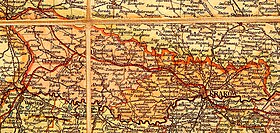 Location on the map Western border of the UK Fr. Krakowskie with Silesia marked with a red line running along the river. Przemsza. North and east the border with the Kingdom of Poland marked with a red line. The southern border with Galicia ran along the river. The Vistula, leaving Podgórze on the Galician side | |||||||||
| Capital | Kraków | ||||||||
| Area | |||||||||
| • Coordinates | 50°4′N 19°56′E / 50.067°N 19.933°E | ||||||||
| Government | |||||||||
| Grand Duke of Kraków1 | |||||||||
• 1846–48 | Ferdinand I | ||||||||
• 1848–1916 | Franz Joseph I | ||||||||
• 1916–18 | Karl I | ||||||||
| Historical era | Modern Age | ||||||||
| 3 May 1815 | |||||||||
• Annexed | 16 November 1846 | ||||||||
| 1867 | |||||||||
| 31 October 1918 | |||||||||
| 10 September 1919 | |||||||||
| |||||||||
| Today part of | Poland | ||||||||
| 1 Also the Emperor of Austria. | |||||||||
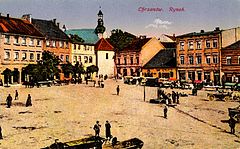
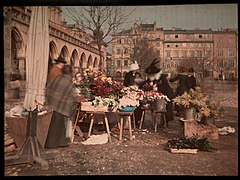
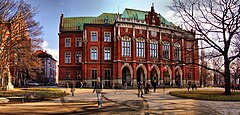
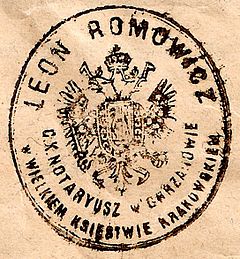
The Grand Duchy of Kraków[1][2] (German: Großherzogtum Krakau; Polish: Wielkie Księstwo Krakowskie) was created after the incorporation of the Free City of Cracow into Austria on 16 November 1846. From 1846 to 1918 the title, Grand Duke of Kraków, was part of the official titulary of the Emperor of Austria.[3][4]
National symbols
[edit]The Grand Duchy of Kraków had its own coat of arms - a white eagle on a red background with the coat of arms of the city on the chest, but it was practically not used. It was similar with the flag of the Grand Duchy, consisting of three horizontal stripes: yellow, blue and white.[5] In Juliusz Kossak's painting entitled The Emperor's Entry into Kraków[6] and depicting the greeting of Emperor Franz Joseph by the inhabitants of Kraków, the flags with which the city was decorated are clearly visible: black and yellow flags of Austria, white and blue city flags of Kraków (former flag of the Free City of Kraków) and a red and white national flag. The flag of the Grand Duchy is not among them.
The separateness of these lands from the rest of Galicia was also visible in the titles of the Austrian emperor. As early as 9 August 1806 the Habsburgs adopted the title of "Grand Duke of Kraków" (Großherzog von Krakau) alongside "King of Galicia and Lodomeria".[7] This title was held by four monarchs: Francis II, Ferdinand I, Franz Joseph I and Charles I. In the case of Francis II, however, it was a purely fictitious title referring to something that did not yet exist during his reign and was probably intended to legitimize the seizure of Polish lands by Austria in the Third Partition, the more so that the ruler also adopted other "empty" titles, such as: "Duke of Sandomierz", "Lublin", "Masovia", covering the territories incorporated into Austria during the Third Partition of Poland.
History
[edit]
The Free City, a remnant of the Duchy of Warsaw, had been made a protectorate, however functionally independent, as a result of the Congress of Vienna (1815). It was under Prussian, Austrian, and Russian trilateral influence until, in the aftermath of the unsuccessful Kraków Uprising, it was annexed by the Austrian Empire in 1846.[8]
At the same time the official name of the Austrian administrative entity containing approximately Galicia, and some Polish areas west of it, was changed to the Kingdom of Galicia and Lodomeria, and the Grand Duchy of Kraków with the Duchies of Auschwitz and Zator.
These entities (Kingdom of Galicia and Lodomeria, Kraków, Duchy of Auschwitz, and Duchy of Zator) were formally separate; they were listed each in the Austrian emperor's titles, each had its distinct coat of arms and flag. For administrative purposes, however, they formed a single province.
The Duchy had its own local government, the Governorate Commission (Polish: Komisja Gubernialna).
Notes
[edit]- ^ Frederic Austin Ogg: The Governments of Europe, Volume 2, 2009 p. 89
- ^ Google Books search: "Grand Duchy of Cracow" used in many English language books.
- ^ James Lyon, Serbia and the Balkan Front, 1914: The Outbreak of the Great War (Bloomsbury, 2015), ch. 1, note 1.
- ^ J. H. W. Verzijl, International Law in Historical Perspective, Volume VI: Juridical Facts as Sources of International Rights and Obligations (Leiden: A. W. Sijthoff, 1973), p. 173.
- ^ Czuma, Mieczysław (2013). Austriackie gadanie czyli Encyklopedia galicyjska. Oficyna Wydawnicza "Anabasis". ISBN 978-83-85931-31-7. OCLC 994641703.
- ^ Grodziski, Stanisław; Wyrozumski, Jerzy; Zgórniak, Marian (December 1998). Wielka historia Polski. Kraków: Fogra. ISBN 83-85719-35-0. OCLC 42862046.
- ^ Martens, Georg Friedrich (1808). Recueil des principaux traités d'alliance, de paix, de trève ...: conclus par les puissances de l'Europe ... depuis 1761 jusqu'à présent ... (in French). J. C. Dieterich.
- ^ The Encyclopedia Americana 1972- Volume 16 - Page 537 By the provisions of the Congress of Vienna (1815) it became the Republic of Krakow, a protectorate of Russia, Prussia, and Austria, but in 1846 it reverted to Austria as the Grand Duchy of Krakow."
References
[edit]- Alfred Regele: Die Einverleibung des Freistaates Krakau 1846. Ungedr. Diss., Wien 1951
- States and territories established in 1846
- States and territories disestablished in 1918
- History of Poland (1795–1918)
- History of Kraków
- 19th century in the Habsburg monarchy
- Former grand duchies
- Establishments in the Kingdom of Galicia and Lodomeria
- 1846 establishments in the Austrian Empire
- 1918 disestablishments in Austria-Hungary


